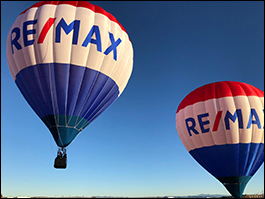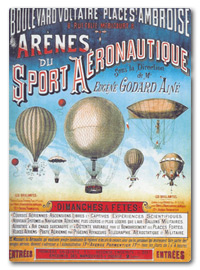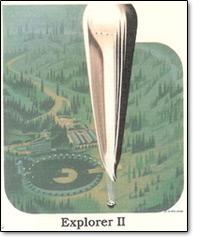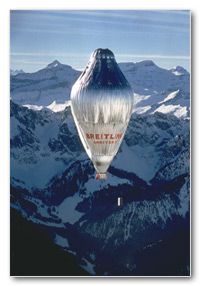The History of the RE/MAX Hot Air Balloons

The RE/MAX Balloon Fleet
A company image seven stories tall! Multiply that by more than 100 and you have one of the largest fleets of hot air balloons in the world. Across North America and increasingly around the globe, the red, white and blue balloons emblazoned with the RE/MAX logo participate in balloon meets, support school functions, highlight charitable and business promotions, and drift above athletic events. And as the size of the fleet continues to grow, images of the tricolor RE/MAX Balloon logo multiply through every visual form of advertising and promotion. The RE/MAX Balloon, and the accompanying 'Above the Crowd!®' slogan are equated in the public mind with the RE/MAX organization.The First RE/MAX Balloon
When RE/MAX began its relationship with hot air ballooning in 1978, the desire was for a marketing image that would get noticed. Word of mouth was spreading fast about the network of highly experienced real estate agents who were proving to be more experienced, productive and knowledgeable than anyone else on the scene. But market studies showed that among consumers in general, name recognition of RE/MAX ranked well below many lesser competitors. Meanwhile, in New Mexico, a few RE/MAX agents and their regional leaders dreamed up the idea of entering a red-over-white-over blue RE/MAX Balloon in the 1978 Albuquerque Hot Air Balloon Fiesta. The RE/MAX ground crew wore jackets with patches that read, "Above the Crowd!®", a phrase devised by an Affiliate. And as often is the case with hot air balloons, the RE/MAX Balloon really grabbed some attention. Plus, the imagery meshed perfectly with the RE/MAX network's emphasis on innovation, freedom and leadership! At International Headquarters, in Denver, the RE/MAX executives immediately recognized that a hot air balloon flying free "Above the Crowd!®" represented independence, freedom, and professionalism - everything the organization had set out to be. They enthusiastically adopted the balloon image as the RE/MAX corporate logo.The fleet of RE/MAX Balloons began to rapidly grow. The first gathering of RE/MAX Balloons was at the 1982 RE/MAX Great Balloon Race in Toronto. Six balloons participated.
Only six years later, 18 RE/MAX Hot Air Balloons were brought together outside Fenton, Michigan. Spectacular helicopter footage of their morning flight over the misty Midwestern countryside provided the basis of the RE/MAX "Take a Step Above the Crowd!" advertising campaign.
The third and thus far the largest mass ascension of RE/MAX Balloons took place in the foothills outside Denver in 1989, when 54 RE/MAX Balloons launched and were filmed in flight for yet another RE/MAX commercial.
The History of Ballooning and Hot Air Balloon Records
 Hints of the hot air balloon appear in many cultures. A fourteenth-century monk's manuscript from England speaks of goatskins flying in the air when placed near steam from soup. As far back as the Egyptians, there have been recorded experiments on the subject of hot air rising. However, the creation of this beautiful flying machine took an age of invention and two competitive Frenchmen.
Hints of the hot air balloon appear in many cultures. A fourteenth-century monk's manuscript from England speaks of goatskins flying in the air when placed near steam from soup. As far back as the Egyptians, there have been recorded experiments on the subject of hot air rising. However, the creation of this beautiful flying machine took an age of invention and two competitive Frenchmen.
The birth of air balloon flight came in the year 1782, with a discovery of two brothers Joseph and Etienne Montgolfier. Their discovery that hot air was lighter than cold air led to the making of a small silk balloon, which they subsequently elevated thirty-two meters in the air. Upon discovering that the hotter the air, the more a balloon rose, the two decided to give a public demonstration of their work in their home town of Annonay, France. They created a globe of 900 cubic meters of cotton spread of a carboard fitting. Then they rigged up a boat of burning straw under the balloon to fill it with hot air. When it was hot enough, they cut the string attaching the balloon to the ground. It rose ten thousand meters into the air, before descending and exploding. News of their discovery was sent to the Science Academy of France.
The Mongolfiers made a promise to their father never to fly their machine. So the privilege of trying out the balloon went to a duck, a sheep and a chicken. On the 19th of September, 1783, the Montgolfier brothers successfully launched a balloon, called 'Aerostat Reveillon', made from paper and cloth. To inflate the balloon they burned a combination of straw, chopped wool and dried horse manure underneath the balloon. As the straw burned it released heat that helped the balloon float. The wool and manure made lots of smoke and helped keep the burning flame low, which lessened the risk of the balloon catching fire. The brothers were far too nervous to try out their invention themselves so they sent up a sheep, a duck and a rooster to see what happened.
After eight minutes of flying, witnessed by the entire Science Academy and Louis XVI himself, the animals were still alive. Louis XVI was quite skeptical about the success of a flying mission, but he nonetheless allowed Pilatre Rosier, a native of Lourdes, to attempt a flight with a passenger. Their flight over Paris lasted 28 minutes, during which both men fed a fire placed in the middle of their partitioned basket.
This discovery won the brothers nobility, and a legacy of flying balloons began. A competition rose up between Pilatre and the brothers as to who could fly the highest. Balloons became bigger. There was a recorded twelve cats sent into the air over Paris at one point for a hydrogen-fueled balloon experiment. The idea of crossing the English Channel, an inevitable goal, rose up as the ultimate challenge. A man named Blanchard flew from England to France and completed the challenge from the English side. The challenge of the longer route, from France to England, still remained. In 1785, Pilatre attempted this flight and died, his balloon burning under him into the Channel. The reason for his flammable end was a small bag of hydrogen that he attached to his basket, near the flames for the larger hot air balloon. This event marked a downfall of popularity for the hot air balloon, and an increase in popularity, ironically, in hydrogen.
Now a large jump in time, of over 100 years: In August of 1932 Swiss scientist Auguste Piccard was the first to achieve a manned flight to the Stratosphere. He reached a height of 52,498 feet, setting the new altitude record. Over the next couple of years, altitude records continued to be set and broken every couple of months - the race was on to see who would reach the highest point.
 In 1935 a new altitude record was set and it remained at this level for the next 20 years. The balloon Explorer 2, a gas helium model reached an altitude of 72,395 feet (13.7 miles)! For the first time in history, it was proven that humans could survive in a pressurized chamber at extremely high altitudes. This flight set a milestone for aviation and helped pave the way for future space travel.
In 1935 a new altitude record was set and it remained at this level for the next 20 years. The balloon Explorer 2, a gas helium model reached an altitude of 72,395 feet (13.7 miles)! For the first time in history, it was proven that humans could survive in a pressurized chamber at extremely high altitudes. This flight set a milestone for aviation and helped pave the way for future space travel.
The Altitude record was set again in 1960 when Captain Joe Kittinger parachute jumped from a balloon that was at a height of 102,800 feet. The balloon broke the altitude record at the time and gave Captain Kittinger the high altitude parachute jump record which still stands today. He became the first man in space and is considered one of the greatest heroes ever.
Distance flights became of interest particularly in the 1980's and 1990's when a group of balloonist raced to become the first to circumnavigate the globe. Maxie Anderson and Don Ida made the first attempt to circle the globe by balloon on 11 January 1981. Starting from Luxor, Egypt to avoid the off-limits air space of the Soviet Union, they managed 4 316 kilometres (2,676 miles), landing in India. In March 1988 John Petrehn set out from Argentina to circle the globe, but winds destroyed his hybrid tandem three-balloon system. A later attempt to circle the earth in a balloon was made by the Earthwinds Hilton team, headed by Larry Newman, beginning in November 1991 and concluding in December 1994 unsuccessfully. Earthwinds Hilton employed an ingenious system designed to use compressed air in an anchor balloon suspended below the gondola to eliminate the need for ballast. Bad weather prevented lift-off of the Virgin Challenger through the 1995-96 launch season in Morocco. The following year, pilots Per Lindstrand and Richard Branson were able to launch the balloon from Marakech, only to be forced down by technical problem the next day in Algeria. A subsequent attempt the next year was cut short when a taxiing jetliner blew the inflated balloon envelope free from its ground moorings. The balloon was recovered in Algeria. The Breitling Orbiter - piloted by Betrand Piccard, Wim Verstraeten and Andy Elson - launched from Switzerland in January 1997. The balloon landed a few hours later when the crew was overcome by kerosene fumes from a leaking valve. In January 1998 the same team set a world record for duration by staying aloft nonstop and unrefueled for 10 days on a flight from Switzerland to Burma. Their flight was cut short when China refused permission to fly over the country.
American adventurer Steve Fosset has attempted the global balloon flight six times. On 8 January 1996 he embarked solo from South Dakota in Solo Challenger. Technical problems forced him to land three days later in eastern Canada. The balloon was rebuilt and renamed Solo Spirit. A year later Fossett launched from St Louis and flew for more than six days before landing in India. Flying halfway around the earth, he set new world ballooning records for distance and duration. His duration record was eclipsed the following year by the Swiss Breitling Orbiter team, but his distance record stood. On 31 December 1997 he made a third attempt with a larger Roziere envelope but had to land in south eastern Europe due to bad weather and technical problems.
 Steve Fossett again launched from Mendoza, Argentina on 7 August 1998 in Solo Spirit. He set a new record covering 15 200 miles, only to be forced down in bad weather off the coast of Australia. Upon landing in the ocean, the capsule turned upside down and began filling with water. The outside of the capsule was aflame, and Fossett was nearly overwhelmed by suffocating fumes from the resins lining the exterior of the capsule. Grabbing his 12-pound life raft and EPIRB beacon, which he had triggered during the descent, he climbed from the capsule as the storm continued to rage around him. Incredibly, he was brought to safety by the Australian coast guard.
At 8:05 GMT on Monday 1 March 1999 Swiss Betrand Piccard, on his third attempt, teaming with Briton Brian Jones, launched the Breitling Orbiter 3 from Chateau d'Oex in the Swiss Alps. They climbed to an altitude of 7'000 meters (21'000 feet) in a little more than one hour, reporting a stunning view of the Matterhorn as they cruised out of Switzerland into Italy. 19 days, 1 hour and 49 minutes later, at 09h54 (GMT) hours on Saturday 20 March 1999 they passed the finishing line of over Mauritania, North Africa, becoming the first balloonists to circumnavigate the globe with a non-stop, non-refuelled flight, having traveled 42 810 kilometres.
Steve Fossett again launched from Mendoza, Argentina on 7 August 1998 in Solo Spirit. He set a new record covering 15 200 miles, only to be forced down in bad weather off the coast of Australia. Upon landing in the ocean, the capsule turned upside down and began filling with water. The outside of the capsule was aflame, and Fossett was nearly overwhelmed by suffocating fumes from the resins lining the exterior of the capsule. Grabbing his 12-pound life raft and EPIRB beacon, which he had triggered during the descent, he climbed from the capsule as the storm continued to rage around him. Incredibly, he was brought to safety by the Australian coast guard.
At 8:05 GMT on Monday 1 March 1999 Swiss Betrand Piccard, on his third attempt, teaming with Briton Brian Jones, launched the Breitling Orbiter 3 from Chateau d'Oex in the Swiss Alps. They climbed to an altitude of 7'000 meters (21'000 feet) in a little more than one hour, reporting a stunning view of the Matterhorn as they cruised out of Switzerland into Italy. 19 days, 1 hour and 49 minutes later, at 09h54 (GMT) hours on Saturday 20 March 1999 they passed the finishing line of over Mauritania, North Africa, becoming the first balloonists to circumnavigate the globe with a non-stop, non-refuelled flight, having traveled 42 810 kilometres.
Not to be outdone, Steve Fossett again braved the skies in a solo flight. On Tuesday 2 July 2002 Fossett became the first to achieve solo circumnavigation of the world in a hot air balloon. The present absolute world balloon altitude record was set 4 May 1961 when M.D. Ross and V.A. Prather piloted a Winzen polyethylene balloon to 34 466 metres (113,739 feet) above the Gulf of Mexico. Tragically, Prather drowned at landing when his pressure suit filled with water. The first successful human flight into the stratosphere was made on 27 May 1931 when Auguste Piccard and Paul Kipfer rose in the first pressurised gondola to 15 781 metres (52,077 feet). To keep the craft warm, they painted the top of the gondola black and the bottom white. But the cabin overheated to 41 degrees Celsius (106 Fahrenheit). A year later, after they had painted the gondola all white, the cabin temperature dropped to a frosty -18 degrees Celsius (0 degrees Fahrenheit) at 16 200 metres (53,460 feet).